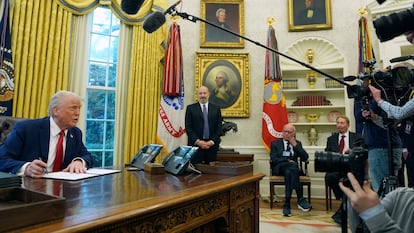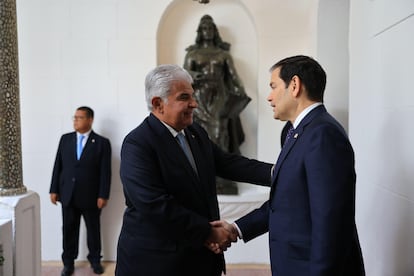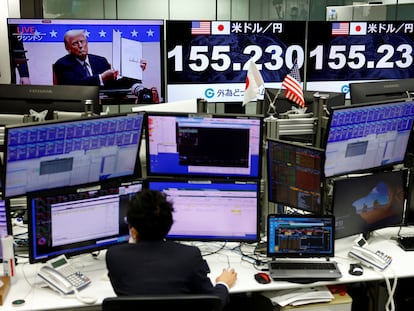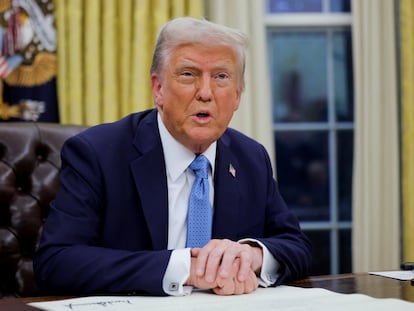Trump scores his first victories with his aggressive tariff diplomacy
The US president has already obtained concessions from Mexico, Canada, Colombia and Panama with his threats. The European Union appears to be next


Donald Trump’s unpredictability has become one of his diplomatic weapons. For a threat to be effective, it must be credible, and with the U.S. president, almost all of them are. In his first term, Trump also brandished levies that were never applied, but this time he has taken his aggressive tariff diplomacy almost to the limit. With trade policy and other threats, he has obtained concessions from Mexico, Canada, Colombia and Panama in two weeks in office, even at the cost of generating uncertainty in companies and shocks in the markets. Trump also takes credit for the ceasefire in Gaza. Despite the doubts that this policy raises, Republicans are showing off their achievements. “At this rate of achievement, not only should President Donald Trump be on Mount Rushmore, I want to personally work the chisel!” tweeted his ally Elon Musk on Monday.
In fact, the large-scale effigies of George Washington, Thomas Jefferson, Theodore Roosevelt and Abraham Lincoln on the South Dakota monument were largely sculpted using dynamite. And Trump has returned to the White House explosively, using speeches, his Truth social media posts and the incontinent signing of executive orders as dialectical bombs to carve out his place in history. The president said Monday in the Oval Office that he is willing to make deals, but it is clear that he prefers to negotiate through pressure.
Will Trump’s threats fail to work if they are not followed through? As long as he obtains concessions, he can maintain this momentum without losing credibility. Mexican President Claudia Sheinbaum has secured a one-month suspension of 25% tariffs on Mexico until March 4, after offering to deploy 10,000 National Guard agents to the border to combat drug trafficking and illegal immigration. It probably wouldn’t have been necessary to push the situation to the limit to achieve this result, but Trump likes to make a show of it, which permanently attracts attention.
The same is true for Canada. Justin Trudeau has agreed to strengthen the border with a $1.3 billion plan. There are also new commitments to appoint a fentanyl czar, label drug cartels as terrorists, monitor the border 24/7, and launch a joint Canada-U.S. force to combat organized crime, fentanyl, and money laundering. Many of these measures were already in place following Trump’s original threat in November. Trudeau has also signed a new intelligence directive on organized crime and fentanyl, which he will provide with $200 million. But Trump’s ambitions are much greater: “Canada should become our Cherished 51st State,” he wrote on Truth Social on Monday. “Much lower taxes, and far better military protection for the people of Canada – AND NO TARIFFS!”
The tariff threat, however, remains in place for a month. Although the executive orders he signed only cite a national emergency over fentanyl and illegal immigration, Trump has made clear that what is behind it is an economic war. In his rhetoric, he falsely portrays as subsidies the trade deficit the United States has with most countries, and especially with the three on which he has threatened to impose tariffs. Addressing that imbalance in the trade relationship will be much more complicated than deploying 10,000 agents along the border.
The European Union is now in his crosshairs. “They’ve really taken advantage, you know, we have over $350 billion deficit,” he said on Sunday. “They treat us very, very badly, so they’re going to be in for tariffs,” Trump said, complaining that the EU does not buy American cars or agricultural products.
Trump has already scored his first major success using tariffs as pressure against Colombia. Colombian President Gustavo Petro rejected the first military flights of deported immigrants due to the conditions under which the transfers were taking place. Trump then threatened tariffs of 25% on Colombian products, which would rise to 50% in a week, and travel restrictions on members of the government. Petro backed down just hours later.
Excessive recourse to threats can also have negative consequences. It increases legal uncertainty and insecurity, which can discourage investment and lead countries to seek alliances outside the United States. Trust in institutions and regulatory predictability have contributed decisively to the country’s economic success.
Other concessions
Panama has also been forced to give in after pressure from Trump, who threatened to strip the country of its sovereignty over the canal that links the Atlantic with the Pacific. On the first stop of his first trip abroad since becoming Secretary of State, Marco Rubio extracted concessions from the government of José Raúl Mulino.
Following the meeting between Rubio and Mulino, the State Department issued an unusually forceful statement: “Secretary Rubio made clear that this status quo is unacceptable and that absent immediate changes, it would require the United States to take measures necessary to protect its rights under the Treaty,” it said.

Mulino said Panama would not renew its agreement with China’s New Silk Road when it expires, a lending initiative to promote and finance infrastructure and development projects that Panama joined after ceasing to diplomatically recognize Taiwan. According to a U.S. source cited by Bloomberg, Mulino assured Rubio that U.S. Navy ships would enjoy free transit through the canal. But this is not enough to satisfy Trump. “They have accepted certain things, but I am not happy with it,” he said Monday. The pressure will be redoubled in a new bilateral conversation on Friday.
Rubio’s trip, which also takes him to El Salvador, Costa Rica, Guatemala and the Dominican Republic, comes amid a freeze on U.S. foreign aid as part of Trump’s “America First” policy. The State Department said Sunday that Rubio had approved waivers for certain critical programs in the countries he is visiting, but details of those were not immediately available.
Although the ceasefire in Gaza was concluded during Joe Biden’s term, Trump also takes credit for it with his threat to unleash “hell” on Hamas. The outgoing and incoming administrations worked together, but Israeli Prime Minister Benjamin Netanyahu, who is due to visit the White House on Tuesday, agreed to the agreement just in time for the first hostages to be released during the celebrations over Trump’s inauguration.
With his America First policy, which some define as sovereignist rather than isolationist or nationalist, Trump has not been averse to negotiating with the government of Nicolás Maduro in Venezuela to achieve his objectives: the release of American prisoners and the acceptance of deported immigrants.
The U.S. president is triumphant about his achievements, which he tends to exaggerate, just as he underplays the successes of his predecessors. On Monday, he spoke about Barack Obama and Joe Biden in the Oval Office of the White House: “We have done more in two weeks than they did in 12 years,” he said.
Sign up for our weekly newsletter to get more English-language news coverage from EL PAÍS USA Edition
Tu suscripción se está usando en otro dispositivo
¿Quieres añadir otro usuario a tu suscripción?
Si continúas leyendo en este dispositivo, no se podrá leer en el otro.
FlechaTu suscripción se está usando en otro dispositivo y solo puedes acceder a EL PAÍS desde un dispositivo a la vez.
Si quieres compartir tu cuenta, cambia tu suscripción a la modalidad Premium, así podrás añadir otro usuario. Cada uno accederá con su propia cuenta de email, lo que os permitirá personalizar vuestra experiencia en EL PAÍS.
¿Tienes una suscripción de empresa? Accede aquí para contratar más cuentas.
En el caso de no saber quién está usando tu cuenta, te recomendamos cambiar tu contraseña aquí.
Si decides continuar compartiendo tu cuenta, este mensaje se mostrará en tu dispositivo y en el de la otra persona que está usando tu cuenta de forma indefinida, afectando a tu experiencia de lectura. Puedes consultar aquí los términos y condiciones de la suscripción digital.
More information
Archived In
Últimas noticias
Christmas loses its festive spirit: ICE fears cast shadow over religious celebrations
‘Sleepless City’: The light of cinema illuminates Madrid’s Cañada Real shantytown
The new language of the workplace: Knowing how to ask AI questions is more important than using it
All the effects of gentrification in one corner of Mexico’s Colonia Roma
Most viewed
- Families demand repatriation of bodies of Colombians who died in Ukraine: ‘This war is a slaughterhouse for foreigners’
- The low-cost creative revolution: How technology is making art accessible to everyone
- Liset Menéndez de la Prida, neuroscientist: ‘It’s not normal to constantly seek pleasure; it’s important to be bored, to be calm’
- Christian Louboutin: ‘Young people don’t want to be like their parents. And if their parents wear sneakers, they’re going to look for something else’
- ‘El Limones’ and the growing union disguise of Mexican organized crime










































